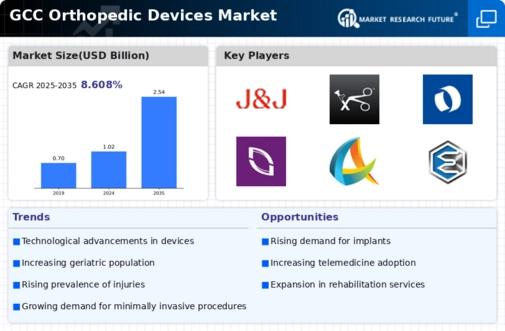Rising Healthcare Expenditure
Increased healthcare expenditure across the GCC countries is significantly impacting the orthopedic devices market. Governments and private sectors are investing heavily in healthcare infrastructure, leading to improved access to advanced medical technologies. For instance, healthcare spending in the GCC is expected to reach approximately $100 billion by 2025, reflecting a commitment to enhancing healthcare services. This financial investment facilitates the adoption of innovative orthopedic devices, as hospitals and clinics seek to provide the latest treatment options. Furthermore, the rise in disposable income among the population allows for greater access to elective orthopedic procedures, further propelling market growth. As a result, the orthopedic devices market is poised to benefit from this upward trend in healthcare spending.
Growing Awareness of Preventive Healthcare
There is a notable increase in awareness regarding preventive healthcare measures in the GCC region, which is positively influencing the orthopedic devices market. As individuals become more informed about the importance of maintaining musculoskeletal health, there is a growing demand for preventive orthopedic solutions. This trend is reflected in the rising popularity of fitness programs and wellness initiatives aimed at reducing the risk of orthopedic injuries. Additionally, healthcare providers are increasingly promoting early intervention strategies, which may include the use of orthopedic devices for preventive care. This shift towards proactive health management is likely to drive the orthopedic devices market, as consumers seek to invest in products that enhance their quality of life and prevent future complications.
Increase in Sports and Physical Activities
The rise in sports and physical activities among the population in the GCC region is driving the orthopedic devices market. As more individuals engage in sports, the incidence of sports-related injuries is likely to increase, leading to a higher demand for orthopedic devices such as braces, supports, and surgical implants. The growing popularity of fitness and recreational activities is encouraging people to seek preventive measures and treatments for injuries. Additionally, the GCC countries are investing in sports infrastructure and events, further promoting active lifestyles. This trend suggests a potential growth trajectory for the orthopedic devices market, as the need for effective solutions to manage and rehabilitate sports injuries becomes more pronounced.
Technological Innovations in Orthopedic Devices
Technological innovations are transforming the orthopedic devices market, particularly in the GCC region. Advances in materials science, robotics, and 3D printing are leading to the development of more effective and personalized orthopedic solutions. For example, the introduction of smart implants and minimally invasive surgical techniques is enhancing patient outcomes and reducing recovery times. The orthopedic devices market is witnessing a surge in demand for these innovative products, as healthcare providers aim to improve surgical precision and patient satisfaction. Furthermore, the integration of digital technologies, such as telemedicine and remote monitoring, is likely to enhance the overall patient experience. As these technologies continue to evolve, they are expected to play a crucial role in shaping the future of the orthopedic devices market.
Aging Population and Increased Incidence of Orthopedic Disorders
The aging population in the GCC region is a primary driver for the orthopedic devices market. As individuals age, the prevalence of orthopedic disorders such as osteoarthritis and osteoporosis tends to rise. This demographic shift is expected to lead to a higher demand for orthopedic devices, including joint replacements and spinal implants. According to recent estimates, the population aged 65 and older in the GCC is projected to increase by over 30% by 2030. This demographic trend suggests a growing market for orthopedic solutions, as healthcare systems adapt to meet the needs of an older population. Consequently, the orthopedic devices market is expected to grow substantially, driven by the need for effective treatment options for age-related musculoskeletal conditions.

















Leave a Comment